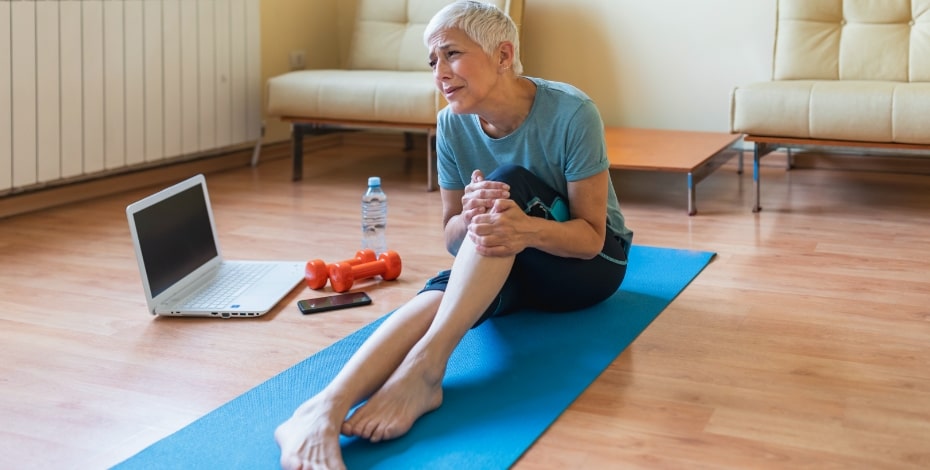
Free resources support exercise for knee OA

Physiotherapists from the Centre for Health, Exercise and Sports Medicine at the University of Melbourne have developed free digital resources to help people with knee osteoarthritis start and stick to regular exercise. Rachel Nelligan, the physiotherapist who led the development and evaluation of these resources during her PhD, discusses how they can assist both patients and physiotherapists.
Free digital patient resources to help people with knee osteoarthritis participate in recommended exercise treatment have been developed by the Centre for Health, Exercise and Sports Medicine at the University of Melbourne in conjunction with people with knee osteoarthritis.
These digital resources were developed in response to an Australia-wide problem—although exercise is a fundamental treatment in osteoarthritis management, many people with knee osteoarthritis are not participating in recommended exercise treatments.
This is in part due to issues of access to suitably trained health professionals to prescribe and support recommended exercise (for example, remoteness, costs and lengthy waiting lists) as well as the challenges people with joint pain face in adhering to regular exercise.
Before our work, free digital patient resources that provide evidence-based exercise and support to people with knee osteoarthritis did not exist.
The resources
We sought to make evidence-based osteoarthritis exercise treatment more accessible to both people with knee osteoarthritis and healthcare professionals.
To do this we designed the patient website My Knee Exercise, in conjunction with people with knee osteoarthritis.
The website provides up-to-date best practice information about knee osteoarthritis and knee pain, guides people on how to increase overall physical activity and describes a 24-week progressive lower-limb strengthening regimen.
The website contains a range of resources, including videos of osteoarthritis experts (researchers, physiotherapists and people with osteoarthritis), exercise videos with recommended progressions and downloadable exercise programs, logbooks and physical activity plans.
The website was designed to be used by people with knee osteoarthritis independently and as a resource that general practitioners and physiotherapists can use to provide evidence-based exercise treatment.
To support the progressive 24-week lower-limb strengthening exercise regimen provided in the website, we also developed an automated 24-week text message program.
These text messages were designed to help people with knee osteoarthritis stick to weekly exercise.
The messages prompt people to monitor their weekly exercise, provide exercise motivation and, if people need help, address common exercise challenges.
The text messages were rigorously designed using behaviour change theory and are based on our previous research, which identified key facilitators and the exercise barriers faced by people with knee osteoarthritis.
The evidence
We evaluated the My Knee Exercise website supported by the text messages in a randomised controlled clinical trial of 206 people with knee osteoarthritis, living across Australia.
In this trial, people with knee osteoarthritis were randomly allocated to one of two groups.
Group 1 used the My Knee Exercise website and text messages to support self-directed structured exercise.

Rachel Nelligan led the development of free digital resources to help people with knee osteoarthritis participate in exercise.
Group 2 used another website that contained the same educational information as the My Knee Exercise website but excluded the 24-week knee-strengthening regimen.
This information is similar to what is currently provided in high-quality osteoarthritis consumer websites.
Our trial has been published in the peer-reviewed journal JAMA Internal Medicine.
It found that six months’ use of the My Knee Exercise website and text messages improved people’s pain and function when compared to the generic osteoarthritis exercise information only.
The website and texts also improved quality of life, self-efficacy and treatment satisfaction.
Excitingly, over 70 per cent of people who used the My Knee Exercise website and text messages experienced a clinically meaningful reduction in their knee pain.
The self-directed program was found to be safe, with no serious adverse events occurring.
Helping physiotherapists
These resources (the website and the text message support) are both now freely available for people with osteoarthritis and health professionals to use.
They can be used together or separately.
Another clinical trial found that the text message support also improved adherence to physiotherapist-prescribed exercise.
Our free resources are already being used to support physiotherapists to provide high quality educational information about knee osteoarthritis to their patients and to help them prescribe appropriate strengthening exercise.
The resources are also being used by people with knee osteoarthritis without intensive health professional involvement.
More than 11,000 people are currently using the website.
Resource access details
The My Knee Exercise website can be found here.
The patient text messages are now available here via My Exercise Messages (which can support any exercise program prescribed for people with hip or knee osteoarthritis).
Click here for more of our free digital clinician and patient resources designed to help physiotherapists deliver evidence-based care to their patients with osteoarthritis.
>> Rachel Nelligan is a physiotherapist and postdoctoral research fellow at the University of Melbourne’s Centre for Health, Exercise and Sports Medicine.
© Copyright 2025 by Australian Physiotherapy Association. All rights reserved.





